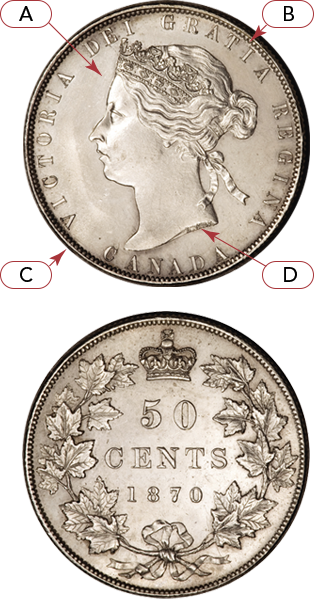- About
- > Anatomy of a Coin
Anatomy of a Coin: Key Terms
Did You Know?
Famous Face
The most reproduced face in history belongs to Queen Elizabeth II, who appears on well over 10 billion coins, banknotes and postage stamps
Determining Value
A coin's value is determined by Scarcity and Grade of Preservation (or 'condition').
Tremendous Range
The Victorian Half Dollar pictured at right can be worth from $50 to $25,000, depending on condition!
Alignment Explained
Coins can be struck with either 'medal' alignment - where both sides are the same side up, or 'coinage' alignment - where front and back are inverted to each other.
A Quick Reference Guide

Coin
A metal disc of either base or precious-metal, normally round, issued under the authority of a government or ruling monarch as a unit of monetary currency to facilitate trade, with a specific denomination/value either explicitly indicated or otherwise understood.
Reverse
The 'tails' side of a coin. On all Canadian and Commonwealth coinage, for example, the opposite to the side bearing a portrait of the Queen. In most cases, the side of the coin with a denomination/value.
Obverse
The 'heads' side of a coin. Where present, the side of the coin bearing a portrait (i.e. the Queen).
Denomination
The negotiable 'face value' of a coin. With rare exception (such as British Sovereigns), the denomination will always be clearly stated on the coin.
Field (A)
The flat or 'blank' part of the surface of a coin which has no design, located between portrait, image, or any other raised design and the text.
Rim (B)
The raised edge of the coin running around its circumference, visible on obverse and reverse.
Edge (C)
The outer surface of a coin between obverse and reverse rims, where the coin’s thickness can be viewed. This edge can be plain, reeded or engrailed, and in some cases has raised or incuse lettering around the circumference.
Date
Numbers indicating the date of a coin's issue. Virtually all coins since medieval time will have a date, although in some uncommon cases it may be located on the outside edge of the coin.
Designer/Engraver's Initials (D)
Letters (or full last name) of a master designer/engraver, which tradition affords the privilege of appearing on the coin depicting his or her work. In this case, the classic obverse portrait of Queen Victoria bears the initials "L.C.W." (for Leonard C. Wyon).


